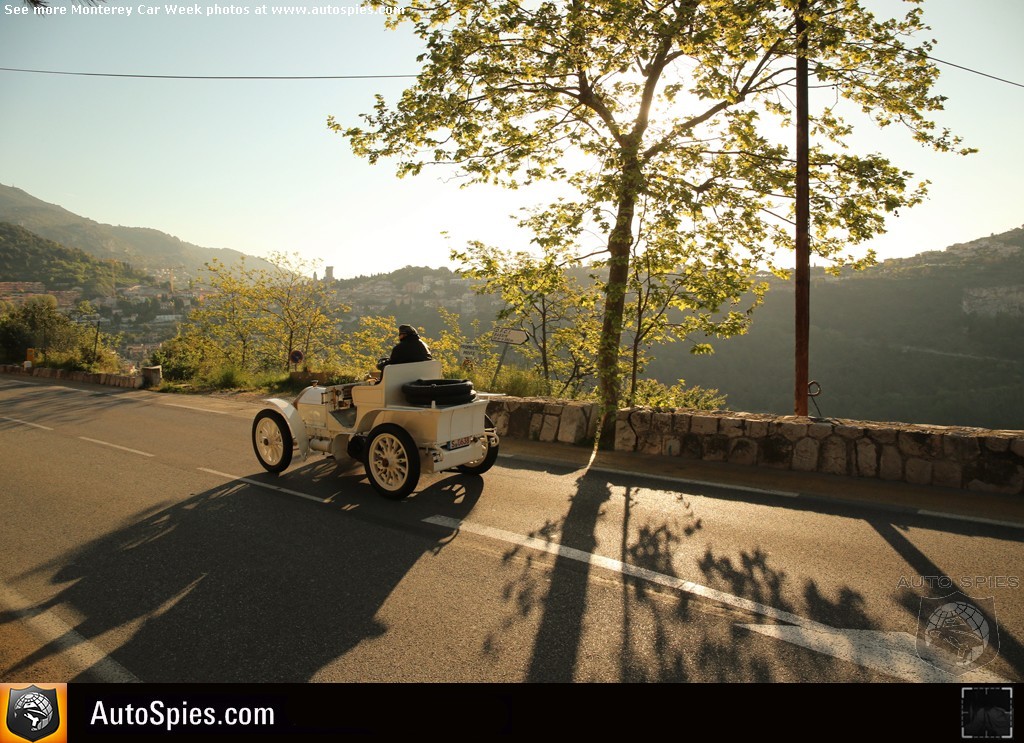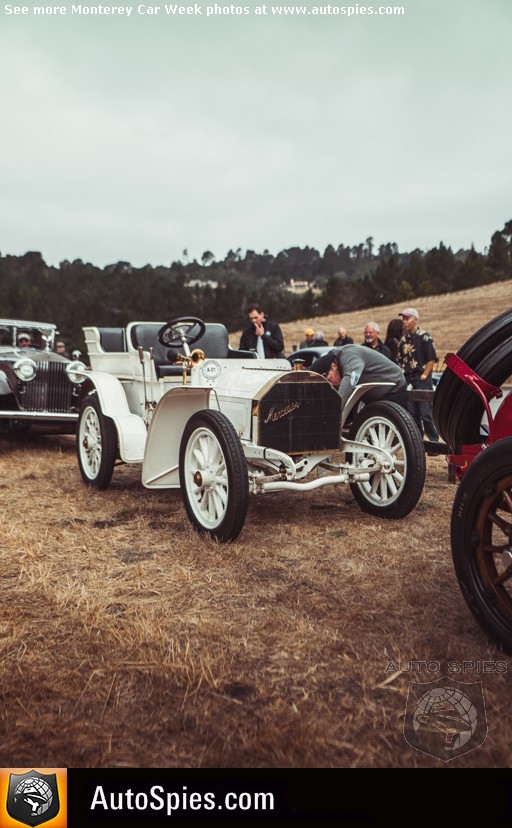If you ever were curious about Monterey Car Week and Pebble Beach, I think this story from Mercedes-Benz sort of articulates why it is a special happening. That's because it is one of the world's foremost destinations for high-end automotive enthusiasts.
While it helps to have some jingle in your pocket, it still can be enjoyed by enthusiasts who appreciate all things with wheels.
Monterey Car Week
This year, Mercedes has done something particularly special. To celebrate its 125 years in racing, the company has trotted out some gems. That includes a 1930s race car that was reconstructed in the only way Mercedes knows how.
The best.
To see some of the three-pointed stars other crown jewels, scope out the press release and affiliated images, below.
Monterey Car Week

Mercedes-Benz's press release follows:
Pebble Beach Concours d’Elegance 2019
Driving premiere of the Mercedes-Benz SSKL streamlined racing car
The Pebble Beach Concours d'Elegance (August 15 to 18, 2019) marks a highlight in the "125 Years of Motorsport" anniversary milestone for Mercedes-Benz: the reconstructed Mercedes-Benz SSKL streamlined racing car from 1932 will be driven on the road for the first time at the world-class classic car event on August 15. The Mercedes-Benz Star Lounge at Pebble Beach offers fascinating insight into the tradition and motorsport heritage of the oldest luxury car brand in the world.
The Pebble Beach Tour d'Elegance celebrates the Mercedes-Benz SSKL streamlined racing car from 1932: this milestone in automotive history will be on the road for the first time during the drive for outstanding classics on Thursday, August 15. Mercedes-Benz Classic has spared no expense in having the vehicle reconstructed in celebration of the "125 Years of Motorsport" anniversary. Alongside the unique SSKL, an elegant Mercedes- Benz 320 n combination coupe (W 142) from 1938 will also take part in the Pebble Beach Tour d'Elegance.
A dream car on a dream road: starting at 7 a.m., the participating vehicles line up on the Portola Road in Pebble Beach. From 9 a.m., the exclusive drive begins, leading to Carmel-by-the-Sea. This tour of significant classics will arrive back at Pebble Beach around 2 p.m. The Pebble Beach Tour d'Elegance partially follows the legendary 17 Mile Drive coastal route along California's Monterey peninsula.
Tradition of luxurious sportiness
At the Mercedes-Benz Star Lounge, the brand presents topics including its origins, tradition of luxury and the "125 Years of Motorsport" anniversary. The lounge will be accessible at Pebble Beach during August 15 to 18, 2019, from 9 a.m. to 5 p.m. Key topics in the history of the oldest luxury car brand in the world are brought to life, from 1886 into the future.
The central "Origins" exhibition area displays an authentic replica of the Benz Patent-Motorwagen – representing the birth of the car in 1886 from the spirit of innovation. The Mercedes-Simplex 40 hp from 1903 is a representative from the family of the first modern cars in the world and as a high-performance vehicle of its time. The upcoming Mercedes-Benz EQC Edition 1886 – much like the Mercedes-Simplex, almost 120 years before it – symbolizes the beginning of a new era of mobility and carries the values and strengths of Mercedes-Benz into the future.
The "Luxury" area stands for the tradition of the highest standards in equipment, comfort, performance and design. Here, the Mercedes-Benz Star Lounge bridges the gap from the current Mercedes-Maybach luxury top models to the Maybach DS 8 Cabriolet from 1932.
"125 Years of Motorsport" anniversary year
A clear focus of Mercedes-Benz presence at Pebble Beach is the "125 Years of Motorsport" milestone anniversary. One of the stars is, of course, the Mercedes- Benz SSKL streamlined racing car. On August 15, spectators will experience its premiere on a public road. As an exhibition in the Star Lounge, the aerodynamically bodied racing car meets the Daimler two-cylinder V-engine, which represents the beginning of motorsport. Vehicles equipped with engines of this type won the first racing car competition 125 years ago – the race from Paris to Rouen on July 22, 1894.
Further automotive highlights from 125 Years of Motorsport in the Star Lounge include a Mercedes-Benz 3-liter W 154 Formula racing car from 1939, a Mercedes-Benz 300 SLR racing sports car (W 196 S) from 1955, a Sauber- Mercedes C 9 Group-C racing sports car from 1989 and the Penske-Mercedes PC-23 IndyCar from 1994. A comprehensive presentation of the latest high- performance vehicles by Mercedes-AMG rounds off this motorsport tradition.
Magic moments in California
The Pebble Beach Concours d'Elegance is one of the most noteworthy dates on the worldwide calendar of automotive classic events. This competition for automotive elegance has been held since 1950 – then with new vehicles and in association with the Pebble Beach Road Race. Since 1955, collector cars have been the focus of the Concours d'Elegance.
Today, the Concours, in which around 200 exquisite cars from all around the world take part, is the conclusion and highlight of the Pebble Beach Automotive Week with its comprehensive program. The actual competition and award presentation at the 18th hole of the Pebble Beach Golf Links takes place on Sunday August 18, 2019, from 10:30 a.m. to 5 p.m.
Spectacular "missing link"
This world-class classic car event is a fitting stage for the driving premiere of the Mercedes-Benz SSKL racing car during the Pebble Beach Tour d'Elegance. This spectacular vehicle, displayed in the Mercedes-Benz Star Lounge following the tour, connects the era of the mighty supercharged racing sports cars of the 1920s and the epoch of the legendary Mercedes-Benz Silver Arrows of the 1930s.
The aerodynamics pioneer Reinhard von Koenig-Fachsenfeld (1899 to 1992) designed a trailblazing streamlined body for the powerful Mercedes-Benz SSKL racing car in 1932. On May 22, 1932, Manfred von Brauchitsch entered the international Avus race in Berlin with this vehicle, which was unusual to spectators of the time (the public promptly dubbed it the "gherkin"), won ahead of Rudolf Caracciola in an Alfa Romeo.
Mercedes-Benz Classic has reconstructed the innovative "silver arrow", as described in a radio report at the time from 1932, with the highest level of authenticity. This includes the lightening holes in the chassis, typical of the SSKL, which were constructed according to the original drawings. In total, the racing car weighs 275 pounds less than the Mercedes-Benz SSK, which served as its basis. The complete reconstruction of the streamlined body according to historical documents was particularly labor-intensive. For this purpose, experts researched the archives of Mercedes-Benz Classic and those at Schloss Fachsenfeld, which the engineer and inventor Reinhard von Koenig-Fachsenfeld transferred to a foundation in 1982.
The victory of the Avus racing car in 1932 is one of the many highlights in 125 Years of Motorsport at Mercedes-Benz. During this era, aerodynamic optimization was established as a key element in motorsport. The brand is commemorating this milestone at the Pebble Beach Concours d'Elegance with the driving premiere and presentation of the iconic Mercedes-Benz SSKL racing car.
The vehicles and exhibits of Mercedes-Benz Classic at the Pebble Beach Concours d'Elegance 2019
Daimler two-cylinder V-engine (1894)
Mercedes-Benz Star Lounge
The V-twin engine Gottlieb Daimler and Wilhelm Maybach developed in 1888 formed the drivetrain of the "Daimler Motor-Quadricycle", also known as the "Stahlradwagen" (steel-wheeled car), a vehicle showcased at the Paris Exhibition in 1889. In 1894, this engine also played a significant role in the origins of motorsport. At the Paris-Rouen race, the world's first motorcar competition in July 1894, Peugeot and Panhard & Levassor vehicles, powered by this V-twin engine, won first prize – and they repeated their success in June 1895 at the first "real" race from Paris to Bordeaux and back to Paris, which included speed ratings. The winning cars featured the V-twin engine designed by Daimler and Maybach, which was manufactured by Panhard & Levassor under licence. The engine installed in the Daimler "steel-wheeled car" originally had an output of 1.5 hp and an engine size of 565 cc. Later variants, such as those used in the first races, delivered up to 3.7 hp from engines up to 1,646 cc.
Technical specifications of the Daimler two-cylinder V-engine
Period of use: 1889 to 1896
Cylinders: 2/arranged in V
Displacement: Up to 1,646 cc
Output: Up to 3.7 hp
Mercedes-Simplex 40 hp (1903)
Mercedes-Benz Star Lounge
The Mercedes-Simplex 40 hp launched in March 1902, superseding the legendary Mercedes 35 hp. The suffix "Simplex" indicated how easy the new model was to operate for its time. Its direct predecessor was the first to define the motorcar's distinctive shape. Characteristic features included the long wheelbase, the light and powerful low-mounted engine, and the honeycomb radiator integrated into the front end, which became distinctive for the brand. The Mercedes 35 hp marked the end of the "horse-drawn carriage" style that had dominated the industry, and is thus considered the first modern car. The "Mercedes era" ushered in by these developments is characterized by a passion for innovation, visionary drive and technical creativity. Mercedes-Benz is now once again applying these same values to advance the future of mobility. Like the very first Mercedes, the EQC and future EQ models are fundamentally designed to make optimal use of an innovative drive concept – in this case, the electric drive. Delivered in 1903, the white Mercedes-Simplex example, on display from the Mercedes-Benz Classic collection, is one of the oldest, preserved vehicles bearing the Mercedes brand. It shows the future of the car as presented at the start of the 20th century.
Technical data – Mercedes-Simplex 40 hp
Production period: 1902 to 1905
Cylinders: 4/in-line
Displacement: 6,785 cc
Output: 40 hp at 1,050 rpm
Top speed: 47 mph
Mercedes-Benz SSKL streamlined racing car (W 06, 1932)
Mercedes-Benz Star Lounge and Pebble Beach Tour d'Elegance
The SSKL, of which only four were built in 1931, was a pure competition vehicle and signalled the crowning achievement of the Mercedes-Benz S series (W 06) with types S, SS and SSK. Aerodynamics specialist Baron Reinhard von Koenig- Fachsenfeld designed a streamlined body for the SSKL, driven by racing driver Manfred von Brauchitsch. The body was comprised of aluminum by Vetter in Cannstatt and mounted on von Brauchitsch's car. At the Avus race in May 1932, the modification had an overwhelming effect: the streamlined Avus racing car had 25 percent less drag than an SSKL with the classic body, giving it an increased top speed that was 12 mph higher. Manfred von Brauchitsch won the race in the futuristic looking car ahead of the previous year's winner, Rudolf Caracciola.
Technical data of the Mercedes-Benz SSKL streamlined racing car
Period of use: 1932
Cylinders: 6/in-line
Displacement: 7,065 cc
Output: 240 hp, with supercharger 300 hp
Top speed: 146 mph
Mercedes-Benz 320 n combination coupe (W 142, 1938)
Pebble Beach Tour d'Elegance
Mercedes-Benz presented the 78 hp type 320 (W 142) in 1937. The comfortable and powerful six-cylinder model of the luxury class was built in two wheelbases and countless body variants –like the type 290 (W 18) before it. Mercedes-Benz only produced the shorter type 320 n with a 113.4 in wheelbase for two years, whilst the type 320 with a 129.9 in wheelbase was built until 1942 (with a 3.4-liter engine from 1939). The 320 n combination coupe presented itself as a sportily elegant version of the W 142 model series – just like the Cabriolet A that was also available. At its market launch it had a list price of 12,300 marks and was therefore around 3,300 marks more expensive than the sedan with a sliding sunroof. Back then, the term combination coupe described a cabriolet with a detachable hardtop. The vehicle from the Mercedes-Benz Classic collection taking part in the Pebble Beach Tour d'Elegance, underlines an enduring legacy of automotive elegance with its two- color paint finish in red and black.
Technical data of the Mercedes-Benz 320 n combination coupe
Production: 1937 to 1938
Cylinders: 6/in-line
Displacement: 3,208 cc
Output: 78 hp at 4,000 rpm
Top speed: 81 mph
Monterey Car Week













